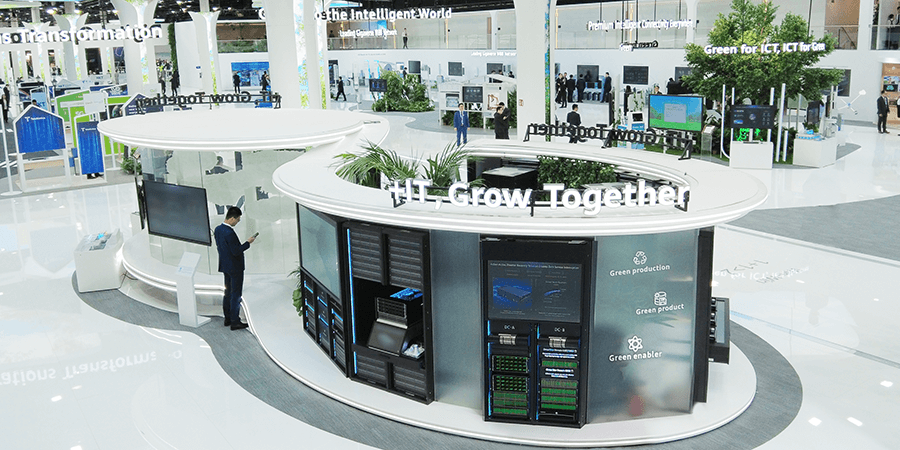At MWC 2023, Huawei debuts a future-oriented IT infrastructure architecture to drive carrier transformation in a digital-first era, placing the spotlight on intelligent, reliable, efficient, and collaborative IT infrastructure in line with its theme of “+IT, Grow Together.”
Digital transformation of carrier operations is advancing across economies worldwide, and at the heart of this evolution is the role of IT infrastructure as an engine for change.
According to IDC, carriers’ digital transformation expenditure will grow at a compound annual growth rate (CAGR) of 17% in the past five years, with investments in IT infrastructure growing at a CAGR of 14.5%. By 2025, IT infrastructure is predicted to be the second-most invested area driving carriers’ digital transformation.
With the telecom industry entering a new stage of growth, Huawei unveils, for the first time in 2023, a future-oriented IT infrastructure architecture as the foundation for carriers’ digital transformation.
Distributed Cloud Architecture to Support Transformation and B2B Service Growth
Cloud-based transformation will grow at a CAGR of 27% in the next five years, according to Gartner’s findings. With cloud-based transformation deeply entrenched in a carrier’s evolution, Huawei’s next-generation IT infrastructure solution synergizes the benefits of distributed cloud architecture, a unified storage resource pool and diversified computing power to yield breakthroughs in carrier operations.
Having supported over 140 carriers’ digital transformation by the end of 2022, HUAWEI CLOUD channels its understanding of carriers and its successes in the industry toward accelerating carriers’ transformation and realizing the benefits of connectivity.
HUAWEI CLOUD’s distributed cloud architecture caters to adaptive carrier needs, supporting the deployment of traditional and new services both on-premises and on the public cloud to deliver a consistent experience online and offline. The HUAWEI CLOUD Stack features the widest range of high-level on-premises cloud services and is the only on-premises cloud that reuses installed base storage. Additionally, its public cloud enables one-stop software development and data governance production lines to facilitate rapid service innovation.
Pre-integrated cloud solutions offer security, reliability and rapid innovation. Software services pre-integrated with HUAWEI CLOUD offer improved network performance through CCE (Cloud Container Engine) Turbo and optimized cloud resource utilization, resulting in a lower total cost of ownership (TCO) and shorter time-to-market.
This is exemplified in Dialog’s multi-cloud digital transformation journey, supported by HUAWEI CLOUD Stack as a one-stop platform to meet all on-premise and public cloud service needs. Built on the three cores of open architecture, open source middleware and DevOps, Dialog’s transformation was focused on yielding optimized TCO, latency, end-customer use cases, edge requirements, data management architecture and go-to-market velocity. Huawei Cloud Stack project enabled Dialog to reduce the TTM of BOM domain application by 30%, and TCO was saved by 20% with the help of Huawei Cloud Stack.
Notwithstanding, HUAWEI CLOUD’s intelligent data lake analyse data from multiple domains by Hetu Engine and sources to fulfill one-stop data governance through digital and intelligent convergence.
Where carriers are exploring new revenue streams in B2B service markets, HUAWEI CLOUD addresses fast cloud services and slow network speeds during enterprise cloud migration by combining NaaS with cloud services to provide one-click cloud network provisioning and a reduced provisioning time from two weeks to several days. Overall, seamlessly integrating network, 5G and cloud capabilities shortens end-to-end latency of private lines and intra-cloud networks and enhances the reliability of private lines and intra-cloud networks
Unified Data Storage: All-Scenario Foundation for Carriers’ Data Infrastructure
More people are deriving business value from data and analytics, based on findings by OnAudience showing that the global data market grew by 26% from $41.4 billion to $52.3 billion in one-year time.
Moving forward, the interest in data, a core asset of carriers’ digital transformation, will only continue to build momentum as 5G services and applications are expected to generate a 22-fold increase in data by 2023, compared to 2021.
Amid this massive data surge, increased data security scrutiny across governments places pressure on today’s carriers to build a future-oriented data foundation that is secure, efficient and intelligent to fully unleash the value of data.
In the near future, 93% of carriers will move to multi-cloud architecture. Huawei, in anticipation of future trends to support next-generation carrier data infrastructure, offers OneStorage to provide a multi-cloud architecture in all scenarios, enabling data mobility and app deployment across multiple clouds, and providing high-performance and large-capacity storage resource pools to accelerate carriers' intelligent upgrade of data storage solutions.
OneStorage’s open architecture supports multiple public and private clouds, with tiered data storage implemented to enable free data flow across clouds and a reduced TCO for carriers. Its enhanced containerization capabilities, with resource provisioning efficiency being 30% higher than other solutions in the market. The solution also reduces energy consumption by more than 50%.
Another feature of OneStorage includes zero interruption of core services and zero data loss with highly reliable equipment and solutions for disaster recovery, backup, and anti-ransomware.
Achieving many firsts in the industry, Huawei’s Dorado storage for production centers yields the highest reliability of 99.99999% in the industry. It is the only SAN and NAS active-active solution for disaster recovery and an E2E anti-ransomware solution that records the highest ransomware identification rate. OneStorage also has the highest hardware density in the industry, or 5U 120 disks. With the use of a large proportion of Huawei erasure code (EC) and data deduplication and compression algorithms, the data storage utilization rate is also 20–30% higher compared with the industry.
In the wake of new industry challenges and emerging opportunities, Huawei is committed to optimizing IT infrastructure architecture to unleash the value of connectivity and support carriers’ digitalization. By converging communications technologies and ICT, software and hardware, and online and offline solutions, Huawei will evolve and grow dynamically with carriers worldwide.
Click here to learn more about the future-oriented IT Infrastructure Architecture Solutions.





